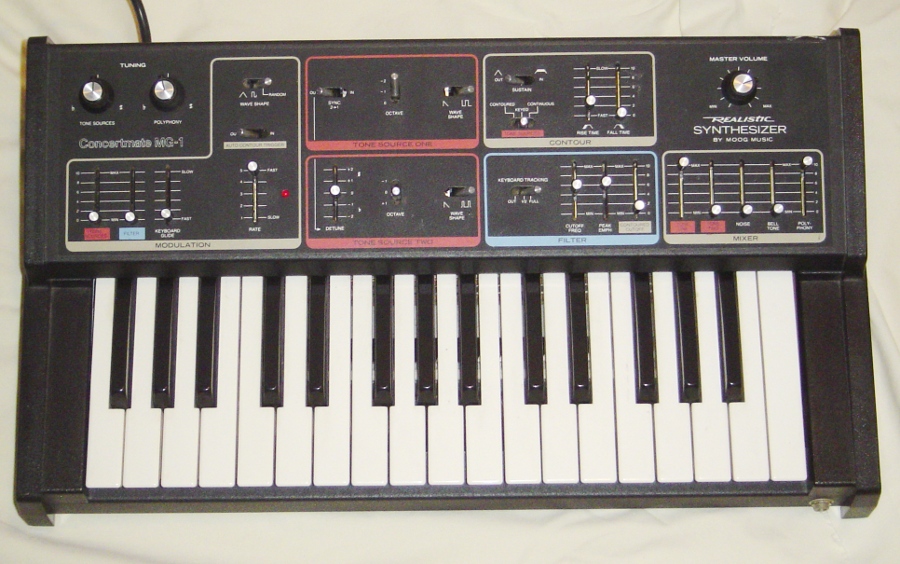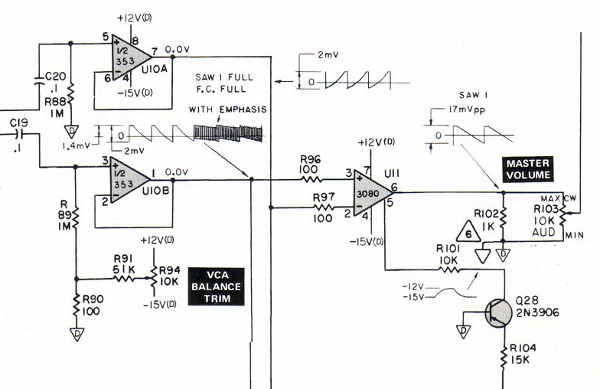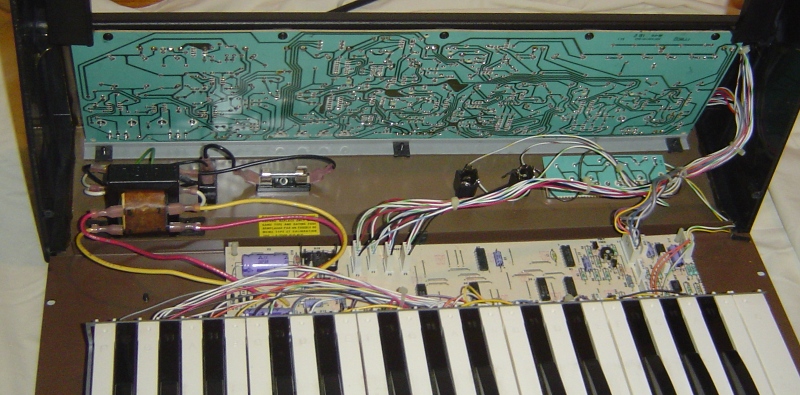
The main problem with the MG-1 was a loud click (a bit like a kick drum) when I pressed or released a key. It sounded suspiciously like a DC signal being applied to a speaker. The second problem was that when I set the contour for an attack and decay, the note got louder and softer, but as the note got softer it was replaced with a buzz at the frequency of oscillator 1.
Conveniently, the Service Manual is available online. I studied it and the schematic, and my first guess was that there was a DC offset going into the CA3080 amplifier, resulting in an amplified DC signal in the output. The CA3080 is not a normal amplifier but an operational transconductance amplifier, an unusual amplifier where the current on a control input controls the amplification of the input signal (more info). In this case, it is used as a voltage-controlled amplifier, allowing the contour signal to control the output.
In the schematic below, op-amps U10A and U10B feed the differential output signal into the 38080 amplifier. Pin 5 of the 3080 receives the contour signal to provide the attack and decay when you press a key. This signal controls how much the inputs are amplified. The output goes into the master volume control, and then to the synthesizer outputs. If there's a DC offset between the input pins 2 and 3, there will be an amplified DC offset at the output.

Fortunately, there is a VCA Balance Trim adjustment to trim any DC offset, and the manual describes how to adjust this. I opened up the MG-1 and adjusted this, but unfortunately it made no difference at all.
Next, I stared at the schematic for the contour generator that feeds into the CA3080 amplifier, but couldn't see how that could be going wrong. I measured the inputs to the CA3080 with an oscilloscope and found they all seemed normal. However, the output showed a 3.75V DC jump when the key turned on, which explained the click. In addition, the contour input showed it was picking up some crosstalk from the oscillator 1 trace that runs next to it, and this was being amplified into the buzzing noise.
All signs pointed to a problem with the CA3080 amplifier chip, which was somehow amplifying a big DC signal. Unfortunately, the CA3080 is no longer being manufactured and is hard to obtain. Fortunately, by some bizarre twist of fate, I happened to have one in my rather small box of parts.
The picture below shows the two main circuit boards. The upper board is the sound generation, filtering, and amplification, while the lower board has the power supply, keyboard, control, and polyphonic sound.

I removed the circuit board, soldered in the new CA3080, got the switches centered just right so the circuit board could be replaced, and put it back together. Unfortunately, I didn't get any output at all. I was afraid I'd somehow destroyed my rare CA3080 chip, but fortunately discovered that if the switches are in intermediate positions, you don't get any signal. I returned the switches to their proper positions and all was well.
In conclusion, I succeeded in fixing my MG-1 and getting that lovely, rich Moog sound.
4 comments:
gosh! I am jealous!!!! What a cool synth. There are potentially several more mods you can do to this thing to make it shine.
let me know if you ever get bored and want to sell it.
[email protected]
Ken,
I'm about to embark in the same repair but noticed an abundance of CA3080 / CA3080E even on Ebay.
We are interested on learning this type of stuff. Shoot us a message on our site.
Oddly enough, the CA3080E chip is a compressor related OTA (Operational Transconductance Amplifier), not a basic OP amp. Googling info on this chip also proves it further. You will see a lot of conversation related to it's use in a compressor circuit. So I guess my question would be, is there some type of compressor related circuit within this synth ?
Post a Comment